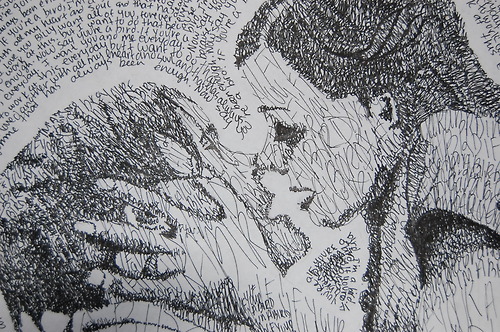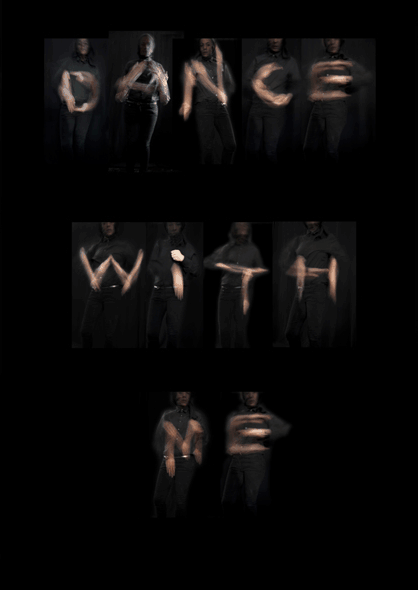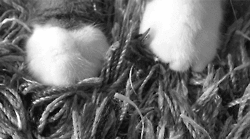Notes on a talk by TT at Centre of Gravity, 180 Sudbury Street, Toronto. Spring 2011.
The Call
Standing in a circle of darkness
Eyes facing the four directions
Relinquishing this body of flesh and bone
Don’t you know
Lightning strikes gods and demons alike
Breathing in the celestial fragrant air.
Bathing in the womb of the great mother
Uttering mysteries with lips tightly shut
Revealing.
It’s safe
Come
C o m e
Home
Theodore Tsaousidis
“Uttering mysteries with lips tightly shut.” We’re used to receiving information through our sense doors, such tiny instruments to receive the vastness of the universe, of this moment. Shamanism is about shattering the vehicle we are in, and becoming a greater vehicle in order to journey to wherever you need. How are you going to receive the mysteries with lips tightly shut? (Obviously, not as ideas, not as stories) How will you respond?
It’s like being hungry and asking me, “Theodore, can you eat a sandwich for me?” Shamanism is an experiential path. It can’t be shown by talking. It’s like trying to empty an ocean with a fork. Even a spoon would give you a chance, but with a fork… I can talk to you about pomegranates for hours, but knowing only comes in tasting them yourself.
I started speaking because I believe that the loss of these teachings has been the result of our present world state individually and globally. We are in trouble. We as a species are in trouble and our planet as we know it is in trouble. We have become a parasitic being – killing its host not realizing that we are actually consuming our own body. The shamanic and yoga teachings show us that we live, we exist in relationship to everything else. We need everything. Everything has a purpose. Everything has intrinsic nature. To ignore the right and place of all other beings including the natural world has been our challenge. Man has separated themselves from this intrinsic relationship — so those who walk in respect and harmony with all things must speak up. This ignorance of believing that we are above and separate from the natural world makes it difficult for the voices of mutual respect, cooperation, care and compassion to be heard. The only way to turn the tide is for everyone to have a direct experience of the sacred relationship that we all belong to. We must do what we can for ourselves, our communities and those who do not have a voice including the natural world. Please do not remain silent.

Both Worlds
In my opinion shamanism is the foundation of all spirituality in the world. It was the first response to questions of meaning. “Who am I?” “What is this all about?”
Interestingly, the first shamans were women. Women have an intimate connection to cycles of nature, Mother Earth and healing herbs, so this is understandable. See with me the vision back 70,000 years ago on a plateau, a human being sensed the wind caress her body. At that moment she remembered the language of the earth and understood. There was no duality in the response. The mind was there but something bigger was in relationship with her body/world. The shamanic path or experience is that primordial relationship available to all of us helping us to reconnect to earth, our bodies, to all things animate and inanimate.
The word “Shaman” appeared in the West in the 19th century and came into more popular use after a surge of interest in the 1950’s and 1960’s. There is some controversy around the origin of the word shaman but it appears to have come from the area of Siberia. There are religions and spiritual practices around the world that are engaged in the use of shamanic technologies – that are not named as such – simply because different words for “shaman” are used in different cultures. When I grew up we too did not have the word “shaman” – however, the same techniques were used to enter different realities at will. There is a physical reality, and there is other reality that is not immediately perceivable. A shaman lives in both worlds.
Shamanism
The journey of shamanism is beyond race, culture and religion. It allows one to go outside of cognition and structure into pure, non-discriminative, awareness. In this state, one can sense, see, hear, feel and intuit more deeply. Shamanism is the experience of non-ordinary reality, where time and space disappear. We have all had this type of experience in dreams, synchronicity, through illness, or in times of deep impasse. This is “the vastness” of what it means to be conscious and to be aware that we are beings without boundary and not just physical beings.
To go outside of cognition and structure into pure, non-discriminative, awareness. In this state, one can sense, see, hear, feel and intuit more deeply. Shamanism is the experience of non-ordinary reality, where time and space disappear. We have all had this type of experience in dreams, synchronicity, through illness, or in times of deep impasse. This is “the vastness” of what it means to be conscious and to be aware that we are beings without boundary and not just physical beings.
When we are truly aware of our spiritual existence, then our world and our experience in it becomes a journey in which we can access a boundless array of tools, guides, and knowledge – all of which encourage and inspire us to explore the non-dual aspect of experience or the non-separateness of self and other. No matter what one’s belief system, the inner shamanic journey itself is consistent and similar wherever one is in the world. It is not affected by ones ideology, projections, or biases. The actual experience takes over and one’s thinking mind is just there for the ride. One’s consciousness is moving at the rate of speed wherein it is virtually impossible for the illusion of the “little self” to interfere.
The Shamanic Journey enables one to intentionally enter into an altered state of consciousness and access strengths and knowledge that were not apparent in relative consciousness.
The world is both form and formless. Both are real and must be experienced for true wisdom to deepen – which is ultimate healing.
Dying to Live
Ordinary reality is that reality which is immediately perceivable by the senses. Non-ordinary reality is beyond the outer form of the five elements. It is described as the world of spirit where everything is dynamic, alive and interconnected. My personal training to learn to walk freely in both worlds was by entering the other world and while there being destroyed and reborn over and over again – for three years. For those who understand “Chod,” you will have a sense of what this is. (Chod is a Tibetan practice where one visualizes giving one’s body to gods and spirits as a way to cut the attachment to self and ordinary reality.) My experience was not voluntary. I did not filet and sacrifice myself as an offering. It was an organic process where I could not tell from moment to moment what would happen next. It had nothing to do with what I wanted and what I didn’t want. Without this type of experience one cannot walk freely and intentionally in these worlds. Only by dying and being reborn can you know the terrain. This is how a shaman is forged. Generally speaking it is through suffering that we can grow the most. For a Shaman it is survival itself. Fritz Pearls says “in the process of transforming our lives, to die and be reborn is not easy.” In the same vein, there is a Sufi saying, “In order to live with eyes open, one has to die in order to live. If you die before death then your life is not in vain.” Learning to “journey” was also part of my childhood training. Journeying is the ability to enter portals of non-ordinary reality and to have the endurance and stability to be able to train in these realities. My teachers were able through their questioning and insight to know if I was hanging out in some kind of fantasy realm of my own making or if I had actually entered those awesome terrifying and spectacular worlds. As a young child, it was not necessary that I understood what I experienced but important that I had the ability to communicate clearly what I had seen and experienced. Learning to perceive without judgment was more important than understanding or interpreting what I saw – as insight is gained through the maturity of the physical brain and mind.
In the west there are many misconceptions about shamans. There are people who work with healing plants, and hallucinogenic substances – and these can have validity, but if the experience(s) cannot be replicated they are questionable. The work of a shaman is to consciously walk in both worlds to bring order, balance and harmony. Others who do not have proper guidance by a shaman skilled in using hallucinogenic substances can cause harm unintentionally. It would be similar to drinking a lot of alcohol and through intoxication one is forced out of one’s body without the foundational stability and strength required. These types of experiences can be dangerous. It is possible that one could absorb negative influences that not only affect that person but also others around them.
In ancient Greece, spirit beings were seen in the reflection of the person encountering them. In the Mayan culture or in the Mongolian culture, the spirit world appears as a reflection of that culture. The beings and the spirits appear to us from our own inherent, genetic, cultural and spiritual experience. If they don’t appear within this cultural conditioning framework, then perception and communication is impossibility. For example, if you are a Christian, you will see Christian imagery and beings. A Hindu will see Hindu imagery and so on. Let’s not mistake the imagery and language as the message. It is the spirit or essence and intention behind the imagery and language that is the message.
Unfortunately, people remain “stuck” in the imagery and words and do not see past “superstition” to the wisdom, clarity and truth beyond. This is mainly due to the experiences of the human psyche, human conditioning, and ego states. Whenever, it is stated that something is “good” or something is “bad” be aware. In mature shaman healers there is no separation or concept of duality in their experience of the two worlds. When one allows superstition and the concepts of worthy and unworthy, good and bad one falls into the path of ignorance to why there are illnesses/problems both individually and planetary. Hierarchies are created and power structures begin to arise – thus time and energy are wasted controlling and forcing artificial expression and views of self and the world- to the detriment of those seeking guidance. A true Shaman knows by experience that all illnesses and all problems arise out of imbalance. Here is where we enter the difficult truth that not all healers, seers, shamans are skillfully trained and one must practice discernment in seeking help from practitioners.
Threats
My lineage of the Pontos people in Asia Minor goes back 3.5 thousand years. The word “Pontos” means “child of Gaia” and our history is filled with myths and stories of oracles, seers, healers and heroes. For example, do you remember the Greek myth of Jason and the Argonauts? He travels on a ship called Argo with a group of great heroes to bring back the Golden Fleece. If he can bring it back to King Pelias, he will become king. This is actually a shamanic story shared by our seers/shamans to represent their journey to the “other world.” They enter this world in order to bring gifts of healing, and gifts of knowledge to help deal with challenges, struggles and threats to individuals and communities. It is a little known fact that the mythology of Greece and Pontos are actual stories from the non-ordinary reality. From this perspective, these stories are true with all the monsters, creatures, heroes and gods. The fact that these types of stories exist throughout the world indicate that ultimately the terrain of human struggle is the same for us all – both mundanely and spiritually.
Between 1914-22 there was an exodus from our homeland near the Black Sea to Greece because of genocide inflicted on us and the Armenians by the Ottomans. Because major trade routes went through the Pontus territory, we were not only enriched by many cultures but also invaded by them and the Pontus people suffered greatly throughout their history. Consequently, through the guidance of our oracles, trance dancing was gifted for military training. (Both men and women were taught these dances.) “Trance” warriors fought together as one unit to protect the people. We had to evolve into great fighters for our own survival.

Broken
My learning started early in life. When I was three months old I become ill and nearly died. I still remember that experience. I entered into the realm of the spirit. I went to the other realm for protection while my little body was being healed. This experience of being broken, of having no boundaries, opened a door to live in both worlds. When I was 13, I drowned, died and was revived. This was such an ecstatic experience that I did not want to return but seeing the devastation of my parents at my funeral (I saw the future during this death experience) I chose to come back.
The ability to allow oneself to be broken cannot be taught. Shamans are not made, they are called. Joan Halifax has written a book called Shaman: The Wounded Healer. This term describes the shaman perfectly. All of my learning took place in the spirit world, but with intensity of the experiences, (the perpetual crises, and the confusion) I had to have a strong enough container (mind and body) so that my brain wouldn’t fly apart or in other words, to maintain my sanity. It was through the acceptance and support of my teachers that I was able to hold both realities within a strong mind and body. It was not easy.
As a youngster, I lived mostly with my teacher (aunt) and spent my time in nature while the rest of the kids went to school. I was preoccupied with constructing shrines and altars in the mountains around me, which my teacher encouraged. My parents were not very happy, both of them worked hard to try to prevent me from entering a path of religion and healing. Every day I went to church instead of school. My teacher shared the ancient stories and I would go out into nature and re-enact them. One day my father had enough. I was 7.5 years old. When he found me he beat me nearly to death. I left my body and could see what was going on. From this vantage point, I sensed his rage and felt sorry for him. This was the only time my father hit me. That experience broke me further, taking me between worlds. For example, I remember waking up one morning and asking my mother, “Can you get oranges and banana?” She looked at me strangely, “What are you talking about? There are no bananas and oranges in the village.” I told her that I just came from outside and saw the fruit seller. She said, “You just woke up, what are you talking about?” I replied, “Oh, I was wondering why I was outside barefoot and wearing my pajamas in the village square.” These experiences were not new to me and were sometimes amusing but most of the time they got me into deep trouble with adults.

Shamanism, Yoga, and Meditation
To give you a bit more of my background; when I was fifteen I read the Bhagavad-Gita at least 100 times. It was like finding a long lost friend. In my twenties, I trained in Kundalini Yoga extensively and in my thirties and forties studied other forms of yoga and Tibetan spiritual healing practices. My formal training and primary practice is in Zen Buddhist meditation which I have been doing for the past thirty years.
The shamanic trance is the same experience that is found in a deep practice of meditation in both Buddhism and Yoga as they both deal with the same mind and the same body. In comparison to meditation and the Buddhist practice of jhana/dhyana (eight concentration practices), the shamanic trance begins to arise between the fourth and fifth jhana. (There are many good resources to learn more about these concentration practices. For now it will suffice to say that these practices move from the material, the first four practices, to immaterial, the last four practices).
From the perspective of yoga and the Patanjali Sutras (specifically the Eight Limbs), one practices the first five limbs (discipline, restraint, posture, breath control and sense-withdrawal) to enter the concentration/trance state. From the shamanic experience, it is by entering the trance state that one is inspired to increased discipline and restraint, and to realize the unfolding of an intrinsic moral foundation from which to move forward in the life journey. When one has a direct experience of deep connection and knows that everyone is really a “relative”, morality innately arises. It should be stated here that both Buddha and Patanjali admonish that one must have a foundation of ethics and morality from which to grow a sound practice. This comes about through faith and application through discipline; and can be accomplished by following the example of a skillful teacher within whom you have put your faith – to remembering that old adage “fake it until you make it”.
In Shamanism, Buddhism and Yoga it well known that possible by-products of deep meditation, yoga practices, asceticism or austerities are psychic powers or “siddhas.” In yoga, the term “tapas” came to be applied to the voluntary struggle and sacrifice in the practice of austerities. The term itself refers to “creating inner heat or vitality” through spiritual practice of self-sacrifice for self-transcendence and often times to acquire magical powers. As many know, the “Buddha to be” practiced austerities before his enlightenment and found them unhelpful in his quest for Nirvana. However in shamanism, the experience of meditation states and siddhis are (almost) involuntary but similar to yoga and meditation practices. Some shamans engage in the practice of austerities and meditation to deepen and refine their abilities. These types of practices were specific to shamanic-centered cultures (such as the Tibetan Bon and Mongolian) and were deepened and refined by experimentation down through the milleniums. It must be said, that seeking siddhis or thinking that since you have manifested them that you have attained realization. This is a grave error. The siddhis as well as the “bliss states” are part of the territory of transcendence, not the goal. Without a proper guide, it is difficult to know if one is stuck in these states.
At this point, it is important to note that the practice of shamanism was not for the purpose of “spiritual enlightenment.” It was based on the belief that all illnesses, conflicts and problems had their roots in the spirit realm. The Shaman’s aim was to bring order, balance and harmony individually and collectively. As we know, the ancient indigenous peoples lived in nature. They were rooted in their environment which fed, sheltered and clothed them. They observed their environment as a child would a mother – and were not separate from it. Everything had spirit or an energy that was seen and felt. In this way, imitation of animal and plant postures developed through observation.
Over time it was noted that certain body postures or movements created certain physical and psychological experiences. Thousands of years ago before the systemization of yoga, animal and nature postures were taught to children to help them relate to nature and their environment (turtle, tree, snake, bird) and to also learn to gather and hunt food, and defend their communities. As child I was taught to listen to thunder, rain and wind. Did you know that there’s a posture for listening to the rain? From my experience, the body postures that I spontaneously enter in shamanism are similar to what we call yoga asanas, and there is a consistency, though with some variation, of certain postures producing particular results. For example, the corpse pose, the warrior, tree pose and the lotus posture.
Eventually, with the development of agriculture, and corresponding community hierarchy in the city-states, the natural enfolding wisdom of shamans and healers took a back seat to these power structures. The shaman’s power to guide the community and respect for the shaman was slowly eroded. Over time, those born with shamanic gifts became the seers, the oracles, the rishis…. Components from the practices of shamanism were integrated into evolving religions and spiritual systems. Wisdom and healing became a type of commodity, controlled and handed out by those belonging to “religious/spiritual organizations.” In different parts of the world, shamanism integrated and manifested in different ways of the time. In some cultures, shamanic traditions survived by going underground and were held in secret. The roots of yoga stem from these historical circumstances. In order to maintain these practices the outward manifestations changed to more inward methods of altering consciousness. Yoga, as a result of shamanism reducing its external expressions, moved inward naturally and discovered an expanded territory of transcendence which translated into the meditation practices that lead to liberation.
Outside-Inside
Shamanism is a practice of revelation, a re-vealing. What is already known, it shows again. When you enter that state your DNA, your body, expresses itself. It is profoundly different from modern yoga. In Patanjali’s different stages of concentration we go inside. In shamanism we go in, but then we go out. It has the same pathways of stillness, but then it goes out. Shamanism is about action; its purpose is to serve, to do work. It’s an activity; a job, imagine a caretaker chosen to take on a responsibility. Yoga is a form of creativity, helping the idea of self to come in so one can see who we really are. In shamanism as you journey there’s nothing to grasp, it’s a chaotic ballet and your job is to stay centered in these winds. Shamanistic experience is an explosion: you’re everywhere at the same time. There’s a direction, intentionality, you put yourself on the roller coaster, but you don’t know where it’s going to go. I’m not in control, but I’m aware. Shamans surrender to spectacular wonder.

Is the shamanic journey only for shamans? No. To break free of the conditions of the mind, to break out of the black and white world is for everyone. The shaman is the intermediary between spirit and world. Shaman can see things before they happen, and prevent problems. Three days before my mother died she whispered to me, “I didn’t give birth to you so you can wipe the tears of this earth.” In other words, there’s no longer a strong foundation for this work, a supporting structure to hold these ongoing shamanistic actions. But they’re necessary.
We crave connection not just information. We are nutritionally deprived.
In my village if you don’t have visions or dreams you’re considered sick. In the West, if you have visions, you are considered unstable and ill. The purpose of yoga is to bring us into experience so that spirit and mind are not conflicted but are an inseparable “one”. When I was 23 I was being pulled apart and another shaman rescued me. If it wasn’t for this assistance I may not be here tonight. I couldn’t tell whether something was happening in the dream realm or the physical world.
Intimate
A shaman can’t help but have an intimate relationship with everything. Energy is always coming in and coming out. You’re always being soaked. The difference between shamanistic experience and yoga is that you don’t go slowly inside. For a shaman everything is alive, it has a spirit. As soon as something is constructed it is part of you, part of everything. This piece of paper was made from trees and rain and a shaman experiences this and in trance state he is the piece of paper and all the elements that made it. How can you step anywhere when the ground and everything is alive?
A shaman is an interspecies linguist. Shamans understand the language of animals, spirits, trees, skies and rain. It doesn’t require training, you’re right there. When I enter that space, I become that space. Shamanism is the ecstasy of breaking open. Yoga is the ecstasy of the entry, going to the universe inside you. You are the universe.






